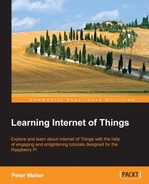In the previous chapter, we learned the benefits of creating applications using the Internet of Things (IoT) platform. In this chapter, we will show you how such a platform can be used to bridge different protocols so that devices and applications in different networks that use different protocols can communicate with each other. There may be many reasons why you would need to bridge between protocols in IoT. A few of them are listed here:
- To include services and devices to talk to other services and devices using other protocols if you're interconnecting systems
- To extend the reach of systems and networks to include areas where different protocols are required
- If you're building services using third-party devices
- If you're building devices that third-party services might want to use
- If you're creating an architecture for distributed and open networks for smart buildings or smart cities
- To allow interconnectivity of consumer electronics for IoT
- To enhance the overall interoperability on the Internet
In this chapter, you will learn:
- The benefits of using a good abstraction model for IoT
- How to integrate protocols into such an abstraction model
- How to bridge multiple protocols in real time using an abstraction model
We will show the basics of how the Clayster.Meterig.CoAP module was developed, which is available in the ClaysterSmall platform distribution and introduced in the previous chapter. We will do this in a parallel project called CoapGateway whose source code can be downloaded for free.
Consider the problem of creating a simple bridge between two protocols, say XMPP and CoAP introduced in the previous chapters. For a device that communicates through XMPP to be able to interact with a device that uses CoAP, a bridge needs to be inserted in between. This bridge would need to be able to translate requests made using XMPP to a request made using CoAP, then translate the CoAP response back to an XMPP response. In the same way, if a CoAP device wants to request something from an XMPP device, the bridge would need to translate the CoAP request into an XMPP request and then translate the XMPP response back to a CoAP response. It is easy to see we need a pair of translators from one protocol to the other and vice versa.
However, what happens if we want to introduce a third protocol, say MQTT, into the picture? In this case, three pairs of protocol translators would be required: CoAP and XMPP, MQTT and XMPP, and CoAP and MQTT. Another complexity arises with the introduction of MQTT. What happens when protocols do not support the same semantics? CoAP and XMPP support the request/response and event subscription patterns, while XMPP and MQTT support the publish/subscribe pattern. MQTT does not support the request/response and event subscription patterns. How should these differences be handled? One way to handle these patterns in MQTT is for the gateway to buffer the latest reported values and report them immediately if requested, as if the device had supported the corresponding patterns. Another important pattern not supported by MQTT is the point-to-point asynchronous messaging pattern.
Note
Note that some patterns available for these different protocols might be similar, but not equal. The event subscription pattern, for instance, differs from the topic subscription pattern in that it allows clients to subscribe individually to events using individual event triggers. The topic subscription pattern does not support individual event triggers, and the subscribers will have to be contented with the triggers defined by the publisher regardless of the application.
If we want to handle four protocols by including HTTP support, we would need six different protocol translation pairs. Out of these, five protocols would require 10 protocol translation pairs, six protocols would require 15 pairs, seven would require 21 pairs, and so on. In general, if N protocols are supported, N(N – 1)/2 protocol translation pairs would have to be supported. Each time you add support for a protocol, the work becomes more difficult. It is clear that this approach quickly becomes impractical and unsupportable. This can be understood well with the help of the following diagram:

Protocol translation pairs grow as O(N2) without the abstraction model
